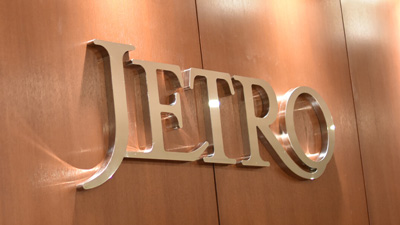Air Seoul Tokyo Branch
Since its establishment of a Japanese base in 2016, Air Seoul, a low-cost carrier (LCC) from Korea, has launched regular flights from Seoul to cities in Japan, expanding its network to 12 routes. With many of these routes to local cities, the company has attracted Korean tourists who want to experience the charm of regional Japan. The company is also actively working to provide passenger services in partnership with Japanese companies. Ok-Hyun Kim; Branch Manager of Air Seoul Tokyo Branch, which oversees 12 branches; spoke with us as Air Seoul’s representative in Japan.

Air Seoul was established in 2015 as a wholly-owned subsidiary of Asiana Airlines. Based from Seoul-Incheon International Airport, it operates regular flights to Japan, Hong Kong, Southeast Asia and Guam, which are popular destinations for Korean tourists. Among the 18 destinations, 12 routes are concentrated in Japan because the demand is high and cost and risk are low due to the short flight distance, making it easier to run stable operations. The large number of not only package travelers but also individual travelers is one of the factors that lends to this stability. Korean visitors to Japan seem to be drawn to tourist resources; such as hot springs, cuisine and shopping; aspects of the culture, such as Japanese hospitality; and the feeling of value for money of traveling to Japan with the expansion of LCC services.
Five regional routes taken over from Asiana Airlines
Of Air Seoul's seven Japanese routes, five (Shizuoka, Takamatsu, Hiroshima, Yonago and Toyama) were previously operated by the full-service carrier Asiana Airlines and were taken over by Air Seoul in 2016. The company added Kumamoto and Ube, bringing the number of regular routes to its current number. Generally, the vast majority of regular flights from Korea are bound for Tokyo, Osaka, Fukuoka and Hokkaido, but there is an increasing trend, and likewise growing customer needs, toward experiencing regional attractions, particularly among repeat travelers to Japan. Air Seoul's local routes are responding to this trend. Furthermore, for regional residents in Japan who are normally forced to take a connecting flight or bullet train to reach a destination within Japan or overseas, the company provides the option of going to Seoul by direct flight and then continuing to their final destination after sightseeing in the city and staying overnight.
To ensure its Japanese business expands, Air Seoul has set out to develop routes it predicts much demand and a large number of flights. The company launched routes to major cities (Osaka and Narita) in 2017 and then to cities that are highly popular with Korean tourists (Fukuoka, Naha, New Chitose) in 2018.

Japan’s Air Seoul regular flight departure/arrival points
Distinguished by an array of independent regional routes and wide seat spacing
Air Seoul's main customers are young people in their 20s and 30s. There is fierce competition with other Korean LCCs that provide regular flights to Japan. Under these circumstances, Tokyo Branch Manager Kim describes Air Seoul's five strengths.
First, there are many independent routes to local regions in Japan. An “independent route” refers to a route in which only one company operates regular direct flights between the departure and arrival cities. Air Seoul is the only Korean airline to have five such independent routes (Takamatsu, Hiroshima, Yonago, Toyama and Ube).
Second is the seat spacing. Of the seven aircraft that Air Seoul leases, six are of the Airbus 321-200 model that were used by Asiana Airlines. These planes feature wider seat spacing than those used by other LCCs, allowing customers to feel the same comfort as they would with a full-service carrier. Being called “an LCC, but not like an LCC” by customers is the highest praise possible and the company’s selling point.
Third, while other Korean LCCs have used their equipment for more than ten years, at Air Seoul the average is five years, giving a feeling of newness and cleanliness as well as ensuring good fuel efficiency. Customers can also charge their devices using the USB ports on board.
Fourth, Air Seoul is the first Korean LCC to designate lavatories for women on its planes. In response to the high proportion of women who travel with Air Seoul for leisure, from September 2018, one of the four lavatories on each plane has been designated for use by women only.
Increasing recognition and sales with conditional pass which can be used any number of times
The fifth and strongest trump card is the “Mint Pass,” with which customers can travel with Air Seoul as many times as they like, with certain conditions, for one year from the date of purchase. The pass is named after the mint color of the Air Seoul logo. It can be purchased only when departing from Korea, and the routes, days and periods that can be used are limited. Peak seasons and consecutive holidays are not eligible for use, but the pass garners good reviews from customers.
In March 2018, Air Seoul launched “Mint Pass J,” limited to seven regional routes, in response to rising demand for flights to local regions in Japan from repeat visitors and other customers. The introduction of this pass has increased the number of passengers and occupancy rates on these routes. Explaining why the company introduced Mint Pass J, Branch Manager Kim says, “Because we were the last Korean LCC to enter Japan, we needed a unique measure to raise awareness. Just selling low-cost tickets for one round trip in the same way as other companies is not a differentiating feature, so we decided to offer the advantage of multiple flights.”
With the success of Mint Pass J, Air Seoul now sells several types of Mint Passes in different series, such as limited to Southeast Asian routes. The company does not offer mileage like other companies, but its customer base is growing thanks to Mint Pass.

Air Seoul aircraft
Working with Japanese companies to provide passenger services
Air Seoul signed a business alliance agreement with Nintendo of Korea and launched a service in September 2018 that lends Nintendo Switch devices to passengers for free on a first-come, first-served basis on Southeast Asian routes with a flight time of four to five hours. In addition, it has been easy for Air Seoul to establish good relationships with regional governments and companies in the regions of Japan where it operates independent routes, since the company is one of the main inbound pipelines, and Air Seoul passengers can benefit from special offers, such as at the duty-free shop in Hiroshima Airport or a golf club in Nagasaki.
The company partnered with a mass retailer in February 2019, and Air Seoul customers can receive discounts at all stores for purchases over a certain price. The store is popular among Korean tourists, so the service is well-suited to Air Seoul customers. For the retailer, which has a strong interest in attracting more Korean visitors, the partnership with Air Seoul, which has many regional routes, is meaningful in terms of drawing business to its stores across Japan.
Enhancing marketing to increase occupancy rates of flights from Japan
In 2016, Air Seoul opened branches in eight cities in Japan and started operating local routes after a very short preparation period. Mr. Kim says, “We also had the advantage that we could use the existing infrastructure of Asiana Airlines.” As a subsidiary, the company was able to smoothly inherit not only the infrastructure but also the trusting relationships with regional governments and residents that Asiana Airlines had built.
In contrast, the company had no existing infrastructure for the new routes that it developed itself, and Mr. Kim says that there were only a limited number of options for securing flight departure and arrival slots due to the company's late arrival to the market. When Air Seoul established its Tokyo Branch, JETRO Invest Japan Business Support Center (IBSC) provided temporary office space, consultation on tax matters, market information and referrals to local interior contractors. Mr. Kim says, “It was a tremendous help being able to rent an office for free and get support regarding the administrative process. In addition, the market information provided by JETRO was reliable and useful as it was primarily collected from public institutions and was different from that we had collected ourselves.”
He describes the company’s future prospects as follows. “In three years we achieved our initial goal in Japan of stable operations and a stable sales system. Going forward, to achieve our goal of increasing our occupancy rate for flights from Japan, we will strengthen our marketing and communications so that Japanese customers feel a sense of familiarity with our brand. We will focus on details such as using social media in Japanese, exposing our brand to the Japanese media, posting detailed information about check-in and baggage on Japanese websites and displaying easy-to-understand information at airports.”
Mr. Kim had the following to say in conclusion: “In Japan, the whole country is working together in preparation for the 2020 Tokyo Olympic and Paralympic Games and responding to the expanding demand from inbound visitors. In addition to contributing to inbound travel to Japan, we will work to expand the number of Japanese tourists visiting Korea by steadily strengthening our operating network in Japan and offering differentiated ideas.”

Ok-Hyun Kim, Branch Manager of Air Seoul Tokyo Branch
(Interviewed June 2019)
Company history
- April 2015
-
Air Seoul Co., Ltd. established in Korea, as a wholly-owned subsidiary of Asiana Airlines
- July 2016
-
First flight as a codeshare flight on Asiana Airlines (between Seoul and Jeju) Japanese branches in Shizuoka, Takamatsu, Hiroshima, Yonago, and Toyama established
- October 2016
-
Started operations between Shizuoka, Takamatsu, Hiroshima, Yonago, and Toyama airports and Seoul Incheon Establishment of 3DNest Inc. in Tokyo
- November 2016
-
Ube branch established, operation between Ube and Seoul Incheon started
- April 2017
-
Kumamoto branch established, operation between Kumamoto and Seoul Incheon started
- August 2017
-
Tokyo branch established
- September 2017
-
Osaka branch established, operation between Kansai and Seoul Incheon started
- October 2017
-
Operation between Narita and Seoul Incheon started
- August 2018
-
Fukuoka branch established, operation between Fukuoka and Seoul Incheon started
- September 2018
-
Okinawa branch established, operation between Okinawa and Seoul Incheon started
- November 2018
-
Sapporo branch established, operation between New Chitose and Seoul Incheon started
Air Seoul Tokyo Branch
- Establishment
-
August 2017
- Business overview
-
Air transport, cargo transport, sales of duty-free goods and souvenirs, preparation and sales of in-flight meals, online sales of air tickets
- Parent Company
-
Asiana Airlines (Korea)
- Address
-
TKM Nihonbashi HamamachoTower, 11F, 2-1-10, Nihonbashihamacho, Chuo-ku, Tokyo, 103-0007
- URL
Support from JETRO
- Temporary office space
- Consultation on tax matters
- Information on market overview
- Referrals to local interior contractors
Related Industry
Regional Information
Explore More
-

Success Stories
Success Stories are based on interviews conducted with foreign companies and foreign-affiliated companies that have successfully come into the Japanese market.
-

JETRO’s Support
We provide consistent one-stop service for establishing a base or expanding business in Japan.
-

Setting up Business
You can find information on overall and detailed steps, cost estimation, an overview of the laws, regulations and procedures related to setting up business, and more.
Contact Us
Investing in and collaborating with Japan
We will do our very best to support your business expansion into and within Japan as well as business collaboration with Japanese companies. Please feel free to contact us via the form below for any inquiries.
Inquiry FormJETRO Worldwide
Our network covers over 50 countries worldwide. You can contact us at one of our local offices near you for consultation.
Worldwide Offices




























